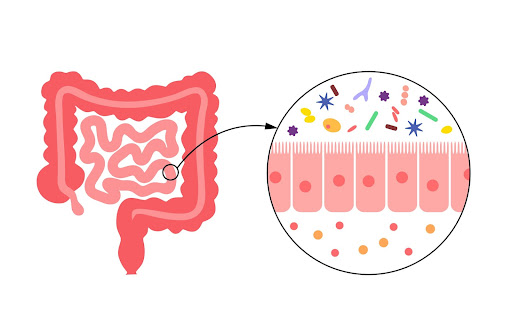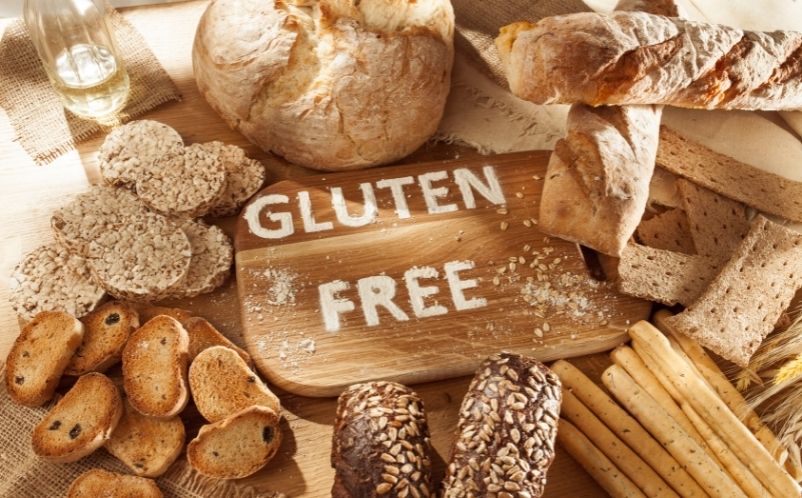You may have heard of the gluten-free diet, but did you know that going gluten-free is way more than just a diet? Some may even consider it a lifestyle! Living a gluten-free lifestyle may be the next step toward a healthy gut, better energy, and a clear mind … even if you think it isn’t for you.There are several simple swaps that can make a meal gluten-free and that can start healing your gut! But first, let’s dive into the science behind gluten!
What is Gluten?

Gluten is a structural protein found in grains such as wheat, barley, and rye. Gluten is what gives bread its structure and texture. Gluten has two main protein subunits: gliadin and glutenin. Gliadins are protein chains within gluten. In an individual with gluten sensitivity, an inflammatory reaction occurs in the walls of the small intestine in the presence of gliadin. This means that the healthy mucosa that covers the small intestine is destroyed by the presence of gliadin. Glutenins are proteins within wheat. Glutenins are responsible for the elasticity and stretchability of dough. This is why glutenins are attractive to bakers when making things such as bread and other pastries.
What does gluten-free mean?
Living a gluten-free lifestyle means following a diet that excludes all foods with gluten. While following a gluten-free diet is beneficial for many reasons, many people choose to become gluten-free in order to relieve the symptoms of conditions such as celiac disease and non-celiac wheat sensitivity. It is important to be aware of which foods contain gluten, as well as which foods may have ingredients that are not considered gluten-free, such as wheat, barley, rye, and sometimes oats.
Who needs to be gluten-free?

There are two types of people when it comes to reactivity to gluten. Those with celiac disease (CD), and those with non-celiac gluten sensitivity (NCGS). Additionally, many autoimmune conditions can warrant a gluten-free diet, since research suggests autoimmune conditions co-occur together.
Celiac disease is an autoimmune condition characterized by an immune response to gliadin. This condition wreaks havoc on the gastrointestinal tract when gluten is eaten. This can potentially cause over 200 different symptoms in the body.
Some of the more notable symptoms include:
- Malnutrition
- Growth problems
- Bone and joint pain
- Bloating
- Chronic diarrhea
- Infertility
- Osteoporosis/osteopenia
- Iron-deficiency
- Skin rashes
- Depression
Celiac disease is characterized by an immune response to a specific form of gliadin (alpha-gliadin) and a specific type of transglutaminase (tTG-2). People with CD make antibodies to the enzyme tissue transglutaminase (that is supposed to fix the damage in your body), and these antibodies attack this enzyme. This creates an immune response to the ingested gluten. An autoantibody (antibody created by the immune system to fight off certain proteins in the body) is created. When gluten is eaten, the immune system kicks into gear. This immune response tells the body to form an autoimmune or defense reaction to the gliadin.
People with celiac disease are often carriers of the antigens HLA-DQ2 and HLA-DQ8. HLA-DQ2 and HLA-DQ8 are gene variants that raise one’s risk of having celiac disease. Gluten interacts with the HLA antigens, which further causes an abnormal immune reaction in the gut.
Then there is non-celiac gluten sensitivity. People with NCGS may experience a range of symptoms including:
- Bloating
- Diarrhea and constipation
- Cramping
- Fatigue
- Weight gain
- Depression
- Weakened immunity
- Brain fog
- Skin problems
NCGS is often correlated with leaky gut syndrome and may be more common than we think. Some studies estimate that 1 out of 20 Americans have NCGS.
Today we are going to focus on NCGS rather than CD.
How is gluten affecting my body?

Gluten mainly affects the digestive tract! The digestive tract consists of the mouth, esophagus, stomach, gallbladder, pancreas, liver, small intestine, and large intestine. But it doesn’t stop in the gut. Gluten has a wide reach on different tissues in the body causing broad and nonspecific symptoms. As mentioned above, some of the symptoms of NCGS include brain fog, fatigue, GI issues, depression, and weight gain.
Unacknowledged gluten sensitivity can increase the likelihood of intestinal permeability, also referred to as leaky gut syndrome. Leaky gut syndrome is a digestive condition that occurs when the lining of the gut is severely damaged and cannot function properly. Remember that the protein gliadin can have a direct effect on tight junctions in the gut. This leads to a “leaky gut” with gaps in the intestinal wall. These gaps can become larger due to constant inflammation, and can potentially allow harmful substances – such as gluten – to exit the gut and enter the bloodstream.
This is how many food allergies and sensitivities originate within the body because the body’s immune system detects the foreign substances and develops an immune response against them. Then, when the individual eats the same food that has leaked through the gaps in the lining of the gut, the immune cells attack the food. This is what causes symptoms in the individual. Check out our leaky gut blog to learn more.
Another way that wheat can affect the gut is through the accidental consumption of herbicides such as glyphosate. Glyphosate is one of the leading causes in the development of celiac disease. Glyphosate is an active ingredient found in herbicides. Farmers use herbicides to control/dry crops such as wheat and sugar cane before harvesting. Glyphosate has been proven to disrupt gut bacteria, which has a negative effect on overall health.
How can one begin to restore gut health?
Probiotics and prebiotics are a great place to start! Probiotics are live microbes that can be ingested through certain drinks, foods, and supplements. Prebiotics are non-digestible fibers that supply the gut with healthy gut bacteria and help heal the GI tract. Beneficial bacteria in the gut will improve the absorption of micronutrients you are consuming. Healing your gut may be easier than you think. If this is interesting to you, check out the healing your gut blog.
Hashimoto’s and Gluten

Molecular mimicry or, cross-reactivity occurs in an individual when the gut comes in contact with a foreign substance that is very similar to the self-antigens, triggering an immune response. In other words, when an individual eats a protein (found in other grains) that contains a very similar structure to gluten, the immune system reacts to this protein as if it were gluten, which could result in bloating or an overall feeling of illness. This condition is relevant to those with thyroid diseases, such as Hashimoto’s disease or hypothyroidism. When an individual eats gluten, antibodies can potentially attack the thyroid because it has a similar structure to gluten. This is why people with autoimmune diseases should consult a dietitian on whether or not it is safe to include gluten in their diet.
Gluten and Secretory IgA
The walls of the digestive tract are covered by immune cells. These immune cells form a protective barrier called Secretory IgA. Secretory IgA protects the walls of the digestive tract against bacteria, parasites, and fungi. In an individual with NCGS, gluten has the ability to break down this barrier. The destruction of this barrier increases the risk of being exposed to infectious agents. This destruction also decreases the ability of the body to absorb nutrients in the foods being consumed. The malabsorption of nutrients can further lead to weight gain, muscle cramping, and hormone imbalances (specifically insulin). If you have any of these symptoms, it might be a good idea to check your Secretory IgA with the stool test. Lab results from a stool test will be able to indicate whether the removal of gluten from one’s diet may be beneficial or not – especially since it’s not something you pick up on without a test.
A high carbohydrate diet:
- Has the power to negatively impact Secretory IgA
- Consists of more than half of one’s total daily caloric intake of carbohydrates, specifically high refined grains.
- May reduce immune functions as well as elevate oxidative stress within the gut.
- Increase the amount of insulin being produced in the body. High levels of insulin in the body can lead to weight gain and other health concerns such as hormone imbalance and heart disease.
How could gluten sensitivity lead to malabsorption?
The walls of the small intestine are covered by microvilli. Microvilli are located on the ends of the villi (often called the brush border). Villi are fingerlike projections that stick out into the lumen of the intestine. Both villi and microvilli are a crucial part of absorption within the digestive tract. However, they can easily be destroyed by the presence of gliadin in the body. Lacteals are located on the surface of the villi. Lacteals aid in the process of digestion by breaking down fat. If lacteals are destroyed by gliadin, deficiencies in the fat-soluble vitamins A, E, D, and K may occur. Symptoms of this would include dry eyes, nausea, poor appetite, muscle weakness, and constipation.

Since gluten can cause inflammatory reactions in the gut, it is very common for an individual with NCGS to also experience nutrient deficiencies. Oftentimes, the body becomes unable to properly absorb fats, proteins, and carbohydrates. The absence of vitamins A and E can make it more difficult for the body to fight free radicals, which can increase the risk of conditions such as liver detox issues, fatigue, cancer, and heart disease. Also, the malabsorption of fats affects the absorption of essential fatty acids such as estrogen, testosterone, progesterone, cortisol, and DHEA. This is very harmful to the body because these reproductive hormones and adrenal hormones are responsible for regulating menstrual cycles, metabolism, the immune system, and other crucial functions in the body. Maldigestion and malabsorption within the small intestine can also lead to amino acid deficiencies. A low amount of amino acids typically result in a low amount of neurotransmitters. Neurotransmitters, such as serotonin and dopamine, have the power to control our feelings and emotions on an everyday basis. This is why it is so important to be aware of gluten sensitivity when it arises because it not only affects the small intestine and large intestine, but it affects our brains as well.
How to live a gluten-free lifestyle

Living a gluten-free lifestyle has become incredibly easy over the past decade. Food brands are constantly creating gluten-free alternatives to everyday food staples and popular snacks. At home in the kitchen, some simple swaps to make a meal gluten-free include substituting a hamburger bun with a kale or romaine lettuce wrap or a gluten-free bun, or even scraping/peeling long strips of squash or zucchini to make “spaghetti noodles.” A gluten-free diet can consist of ancient grains such as amaranth, quinoa, buckwheat, millet, and so much more. Ancient grains tend to be unchanged over the past several hundred years, meaning they are not processed in facilities and use fewer pesticides and fertilizers. There is a wide variety of pasta sold in grocery stores that use ancient grains such as cassava root and quinoa. Along with ancient grains, many brands are now using whole ingredients such as lentils, cauliflower, and even edamame to make pasta. As well as pasta, brands are also using whole ingredients to make bread, crackers, cereals, and so many more food options. By using simple ingredients, these foods not only contain zero traces of gluten, but they also tend to be lower in sodium, have greater amounts of protein and fiber, and have a greater source of vitamins such as vitamin C, vitamin K, iron, potassium, and so many more. The charts below list some recommended pasta brands, bread brands, and everything in between!
PASTA PRODUCTS
| Name of brand | Ingredients | Health benefits |
| Cybele’s Pasta | Green lentil, cauliflower, parsnip | By using whole ingredients, Cybele’s Pasta is able to avoid the top 8 allergens (one of which is wheat). |
| Jovial Grain Free Cassava Fusilli | Cassava flour | The benefits of cassava flour include that it is high in resistant starch, which can help reduce inflammation. Cassava flour is also high in vitamin C. |
| Trader Joe’s Brown Rice and Quinoa Fusilli Pasta | Brown rice, quinoa | Quinoa is high in vitamins such as iron, magnesium, and phosphorus. It contains a lot of dietary fiber as well, which can help prevent constipation. and control blood glucose levels. |
| Seapoint Farms Pasta | Organic soybeans | The use of edamame makes the pasta very high in protein. Edamame is also very rich in fiber, antioxidants, and vitamin K. |
| Hearts of Palm Pasta | Hearts of palm | This pasta is very low in calories, yet high in fiber and protein. Additionally, hearts of palm are a great source of potassium, copper, phosphorus, and zinc. |
| Veggie pasta | Could possibly be: squash, zucchini, sweet potato, eggplant | Vegetables are naturally low in calories and fat. Vegetables also can increase one’s fiber intake, as well as benefit blood glucose levels and immune health. |
| Hodo soy yuba sheets (noodles) | Water, soybeans | Not only are these sheets gluten-free, but they are also plant-based and contain a lot of protein. These sheets can be used in salads or wraps, or used as pasta noodles. |
BREAD PRODUCTS
| Name of brand | Ingredients | Health benefits |
| Bread Srsly: sourdough sandwich rolls | Arrowroot, organic millet flour, organic sorghum flour, water, organic psyllium husk, sea salt | Arrowroot is a starch that is obtained from tropical plants, and it helps stimulate immune health. Psyllium is a form of dietary fiber that can aid greatly in promoting regularity and healing digestive health. |
| Arise Bakery: dark and seedy sourdough | Millet flour, sorghum flour, teff, tapioca flour, millet seeds, sunflower seeds, pumpkin seeds, golden flax seeds, poppy seeds, water, brown rice flour, olive oil, psyllium husk, salt | Sunflower seeds are a great source of vitamins such as zinc and selenium, and they are also great at helping reduce inflammation. Golden flax seeds are beneficial in helping improve overall digestion. |
| Chebe: all-purpose bread mix | Manioc (tapioca flour), modified manioc starch (100% manioc), iodine-free sea salt, cream of tartar, sodium bicarbonate | The less ingredients, the better! This bread mix is perfect for baking even beyond bread. |
OTHER PRODUCTS
| Name of brand | Ingredients | Health benefits |
| Cult crackers: crunchy cassava crackers | Organic cassava flour, organic sunflower seeds, organic sesame seeds, organic flax seeds, organic chia seeds, organic pumpkin seeds, organic coconut oil, organic hemp seeds, Himalayan salt | These crackers are not only gluten-free, but they are also grain-free and high in protein. |
| Trader Joe’s coconut amino acids | Organic coconut sap, water, sea salt | Compared to regular soy sauce, coconut amino acids are both gluten-free and contain way less salt. Lower salt can help lower the risk of high blood pressure and heart disease. |
| Edison Grainery quinoa crispies | Organic golden quinoa | This cereal is made with no salt, flavorings, sugar, artificial sweeteners, additives, chemicals, or preservatives – only quinoa! They’re perfect with just some milk, on top of yogurts and smoothies, and even an added crunch in salads. |
| Purely Elizabeth ancient grain granola | Organic gluten-free oats, organic coconut sugar, organic raw virgin coconut oil, organic sunflower seeds, organic puffed amaranth, organic quinoa flakes, organic chia seeds, organic cinnamon, salt | Not only is this granola gluten-free, but it is made with all organic ingredients and no added flavors or refined sugars! Plus it contains ancient grains such as amaranth, quinoa, and chia seeds. |
| Bob’s Red Mill creamy buckwheat hot cereal | Whole grain organic buckwheat | Buckwheat is very rich in fiber, and fiber is crucial for regulating bowel movement and reducing the chance of constipation. It can also help improve digestive health and balance blood glucose levels. |
| Sprouted Flour Co. | Flours include: organic sprouted millet flour, organic sprouted quinoa flour, organic sprouted sorghum flour | Both quinoa and millet are loaded with dietary fiber, which is super beneficial for your digestive system and can help prevent constipation. Sorghum is rich in antioxidants, which can help reduce inflammation. |
| Simple Mills original organic seed flour crackers | Organic seed and seed flour blend (sunflower, pumpkin, flax), organic cassava flour, organic tapioca starch, organic sunflower oil, sea salt, organic carrots, organic rosemary extract | Both sunflower and pumpkin seeds are great sources of vitamins and minerals such as zinc, iron, and magnesium. Flax is very high in fiber, protein, and polyunsaturated fatty acids. |
It’s better to be safe than sorry when figuring out which foods are suitable for your gluten-free diet. Living a gluten-free lifestyle can become complicated when gluten is hidden in foods that you’d never suspect! Foods such as soy sauce, licorice, and many other foods secretly contain gluten. It is very important to read the listed ingredients on the food label, under “Nutrition Facts.” If there is no label, you can always look up the ingredients on the internet, or join the Symptom-Free for Life Root Cause Master program to get all your questions answered in a live Q&A (keep an eye out for future information regarding this!)
What’s the next step?

Gluten sensitivity and celiac disease can be easily managed by following a gluten-free lifestyle. In fact, the gut can be healed and remain healthy if gluten is removed entirely from the diet. However, the gut will continue to be damaged if the body continues to be exposed to gliadin and glutenin. Long-term exposure to gluten in an individual with a gluten sensitivity can lead to health complications. Gluten sensitivity can often go unnoticed, which is why it is important to discuss your digestive health if any symptoms or worries arise.
A good place to start your gluten-free journey is booking a free 15-minute call with Registered Dietitian Gayatri Saldivar.
References:




